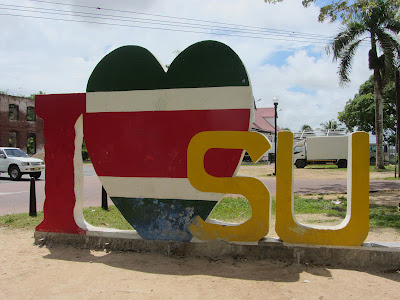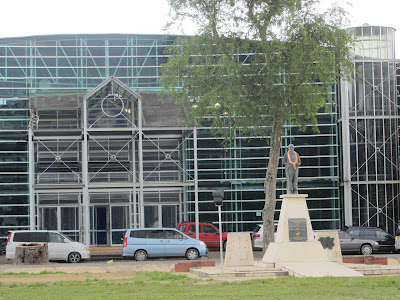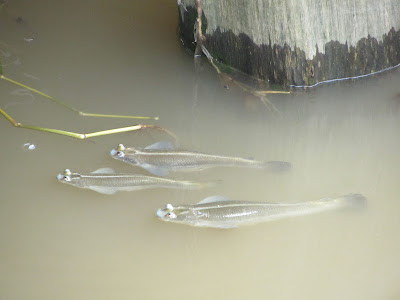Trip dates: April 12 - 15, 2012
Day 1:
The plan is to fly from Paris to Paramaribo, Suriname's capital today. That doesn't happen though. Just after boarding in Paris, a couple of fire trucks pull up to our plane. That's never a good sign. The crew is quick to announce, no worries, there is no fire or bomb-threat, or anything malicious like that. One of the suitcases in the cargo-bay is leaking some strong smelling liquid, and the fire-brigade and police have been called in to investigate. The liquid turns out to be fish-sauce (why would anyone travel with a jar of fish-sauce?), and the gentleman who owns the suitcase is terribly apologetic. Rather than waiting for a clean-up crew, the captain of the plane takes matters into her own hands, armed with some paper towels and a bottle of perfume, she cleans up the mess herself. Finally the rest of the suitcases can be loaded into the plane.
The whole situation would be absolutely hilarious, were it not for the fact that it makes us miss our connection in Amsterdam. So we are overnighting in the Netherlands today.
Day 2:
We finally make it to Paramaribo. Parbo, as the locals call it, is the capital of Suriname, a tropical country just above Brazil, on the Northern coast of South America. One can't look at the history of Suriname without considering the history of the entire Guiana plateau. Inhabited by Native Americans thousands of years ago, it was at first ignored by European explorers. Then, from the 17th century onward, bits and pieces changed hands among the Dutch, English and French colonizers, until the current three entities came into existence: Guyana (English) on the West, French Guyana on the East and Suriname (Dutch) wedged in between. How did the Dutch get hold of Suriname at the end? They traded New Amsterdam (yes, that New Amsterdam, as in New York City) for it.
A couple of years ago I didn't know anything about Suriname, I barely knew it existed. Then we moved to the Netherlands and it all changed. While Surinamese influence would probably not be visible to a casual tourist visiting the Netherlands, once living there we were exposed to Surinamese culture quite frequently. That's when our curiosity about this country arose. And now here we are. Of course not before the minor inconvenience of visiting the small and friendly Surinamese embassy in Paris. Contrary to what the US State Department website says, we had to purchase our tourist cards, which recently replaced entry visas for citizens of some countries, in advance of our trip.

Armed with our tourist cards and yellow-fever vaccination certificates we finally land at Johan Pengel International Airport, also known as Zanderij Airport, at 11 p.m. Then it's almost an hour in the hotel shuttle, on small roads, with plenty of traffic even at this late hour. Despite the dark I am determined to see as much as possible of the countryside, but I am too exhausted and simply can't keep my eyes open.
By the time we arrive to the Courtyard Paramaribo, a nice, modern hotel in a good-looking residential neighborhood, all we can do is collapse into bed.
Day 3:
After traveling for two days, we only got to bed at 1 a.m. today, so we decide to have a late start in the morning. That should be OK, as, according to the hotel receptionist, we can see everything there is to see in the town in one hour. So we linger in the room for a while, enjoying the view of the Suriname River from our window.
 |
| View of Suriname River from our hotel window, Paramaribo |
At 11 a.m. we take the hotel taxi to Fort Zeelandia, standing at the bend of the Suriname River. Its history reflects the history of the entire country. It was built by the French, expanded by the British and completed by the Dutch. Inside is the Stichting Surinaams Museum, but it's closed today.
 |
| Fort Zeelandia, Paramaribo |
Next to the fort is a row of beautiful white wooden colonial mansions, with black detail. This is the historical town center of Paramaribo, and it is recognized as a UNESCO World Heritage Site.
 |
| Historical town center of Paramaribo |
 |
| Historical town center of Paramaribo |
 |
| Historical town center of Paramaribo |
 |
| Historical town center of Paramaribo |
 |
| Historical town center of Paramaribo
|
From here we have a nice view of the modern Wijdenbosch Bridge as well.
 |
| Wijdenbosch Bridge, Paramaribo |
We cross a busy street into Onafhankelijkheidsplein (Independence Square), a former military parade ground and the city's gathering place.
 |
| Onafhankelijkheidsplein, the main square of Paramaribo |
The square is surrounded mostly by pretty, colonial era buildings, including the 17th century Ministry of Finance, which was built from bricks used as ballast in trade ships from Europe. From a much later period are the modern City Hall and The National Assembly (a disgruntled citizen is shouting very angrily at the latter, so we quickly move on).
 |
| Ministry of Finance, Paramaribo |
 |
| Colonial era buildings on Onafhankelijkheidsplein, the main square of Paramaribo |
 |
| The National Assembly, Paramaribo |
 |
| Paramaribo City Hall |
Without a doubt the most prominent building of the square is the beautiful 18th century Presidential Palace. It is currently used for ceremonial functions, and it strikes me how incredibly open it is (no fence).
 |
| Presidential Palace, Paramaribo |
Dark clouds are gathering on the horizon, a storm is coming. So we are picking up pace, wanting to visit the Palmentuin, a palm-tree garden, before it starts raining. We don't have to go far, as it is just behind the Presidential Palace. But we don't make it. Raindrops start to fall, and, by the time we duck under a little roof overhang, it's pouring. We see a tourist racing out of Palmentuin, running for cover. It's a real tropical downpour, so heavy that the water has no place to go to. It starts collecting everywhere, including under our feet. So when the rain slows a bit we make a run for it, finding a more spacious hiding place, which we are sharing with three local men.
 |
| Our first hiding place, under the small green roof |
 |
| Palmentuin in the pouring rain |
 |
| Palmentuin in the pouring rain |
 |
| Our slightly larger second hiding place |
After about 30 minutes the rain slows, and we start walking again. It's hot, so we are not scared of getting a bit wet. There is no point visiting the Palmentuin now, when it's dripping with water, so we walk toward the St. Peter and Paul Cathedral instead. The Cathedral is one of the largest wooden buildings in the Americas, and it seems that it was recently restored. It's fresh coat of yellow paint stands out between the mostly white buildings which surround it.
 |
| St. Peter and Paul Cathedral, Paramaribo |
The beautifully carved interior of the Cathedral looks newly restored as well. There is a band rehearsing inside, and we sit and listen to them, waiting for the rain to stop.
 |
| Interior of St. Peter and Paul Cathedral, Paramaribo |
 |
| Interior of St. Peter and Paul Cathedral, Paramaribo |
 |
| Band rehearsal in St. Peter and Paul Cathedral, Paramaribo |
 |
| One of the windows of St. Peter and Paul Cathedral, Paramaribo |
It's still drizzling when we leave the Cathedral, so we take cover where-ever we can, walking toward the 19th century Dutch Reformed Church on Church Square (Kerkplein). Unfortunately it is closed today.
 |
| Dutch Reformed Church, Paramaribo |
We walk down Heerenstraat, admiring all the beautiful old buildings along the way. They are all wooden, white, with black detail, but far from being the same. One prettier than the other.
 |
| Heerenstraat, Paramaribo |
 |
| Old wooden buildings on Heerenstraat, Paramaribo |
 |
| Old wooden building on Heerenstraat, Paramaribo |
 |
| Old wooden building on Heerenstraat, Paramaribo |
 |
| Some very Dutch-looking buildings in Paramaribo |
We make our way to Keizerstraat, where, reflecting Suriname's multi-cultural nature, stands harmoniously next to each other the biggest mosque in the Caribbean and the Dutch Israeli Synagogue. The country does not have an official religion and, according to one of the tourism brochures, they are "the envy of the world when it comes to ethnic and social integration". It is such an interesting mix of cultures and influences. In many ways it is so very Dutch, at the same time they drive on the left (legacy of the British), and of course feels very tropical as well. They have an amazing mix of people including Creolese, Javanese, Amerindians, Hindustani, Afro-Surinamese and others.
 |
| Mosque and Synagogue side by side in Paramaribo |
 |
| Mosque, Paramaribo |
 |
| Synagogue, Paramaribo |
From here we head to Domineestraat, the town's main shopping street. Apparently people flock here, even from abroad, to buy knock-offs at very low prices. The only shopping we do is for postcards, which we buy in Vaco Press.I have read that this is Paramaribo's best bookshop, but their postcard selection is very poor, a sure sign of an underdeveloped tourism industry.
 |
| Domineestraat, Paramaribo |
 |
| Domineestraat, Paramaribo |
 |
| Shopping center on Domineestraat, Paramaribo
|
We turn toward the river and we pass an incredible assortment of Paramaribo's colorful minibuses "wilde bussen". Painting these minibuses became such an art form that they were featured in a March 31st, 2011 New York Times article. According to this article there are pictures of Hollywood and Bollywood stars on these buses, as are other show-business and even political figures ranging from Presidents Obama and Bush, Nelson Mandela and Gandhi to Saddam Hussein and Osama bin Laden.
 |
| Paramaribo minibuses |
 |
| Paramaribo minibuses |
 |
| Beyonce and Bob Marley on a Paramaribo mini bus |
We reach the river and the city's Central Market. Pick-pocketing is common here, so I am holding my bag a little tighter. I am personally not a big market-fan, and the mixture of scorching heat, high humidity, crowds, smell of fish and chickens is not exactly my idea of a perfect place to hang out, but the market is a must-see if one wants to get closer to local culture. We are mostly looking for the Maroon Market (Maroons are the descendants of fugitive slaves). With bones and sticks and feathers and caged monkeys and medicinal tonics it seems like it would be a fun place to visit. But we can't find it.
 |
| Paramaribo Central Market |
 |
| Paramaribo Central Market |
 |
| Paramaribo Central Market |
 |
| Paramaribo Central Market |
 |
| Fish for sale at Paramaribo Central Market |
 |
| Fish for sale at Paramaribo Central Market
|
We are walking on the riverfront. Fishing boats are bobbing up and down on the river and, if the water wasn't so incredibly dirty here, it would be quite picturesque.
 |
| Suriname River by the Paramaribo Central Market |
 |
| Suriname River by the Paramaribo Central Market
|
Like in the rest of the town, sidewalks are not guaranteed, and the ones which do exist are now flooded after the heavy rain. So we get to experience a couple of hair-raising moments, weaving in and out of traffic. We reach the SMS-pier which, according to our city map, is the best place to shop for souvenirs. There is a modern, air conditioned building with a handful of shops, selling mostly woodcarvings. But, perhaps because it is lunchtime, most of them are closed.
There are fish floating on the surface of the water by the pier and, because the water looks so dirty, at first I think that they are dead. They are not. They are quite bizarre, with their eyes bulging out from the water.
 |
| Some bizarre fish by the SMS-pier, Paramaribo |
There is a nice view from the end of the pier of the many old mansions, many of them old trading houses, lining the waterfront (Waterkant). We walk past these on our way back to Onafhankelijkheidsplein.
 |
| Old mansions alongside Waterkant, Paramaribo |
 |
| Old mansions alongside Waterkant, Paramaribo |
 |
| Old mansions alongside Waterkant, Paramaribo |
 |
| Old mansions alongside Waterkant, Paramaribo |
It's back to Independence Square, where the unhappy citizen has moved from the National Assembly and is now shouting at the City Hall. The rain-clouds are gone, so we can finally visit the Palmentuin, the palm garden behind the Presidential Palace. It's a pleasant place, with shady tall palm trees, benches, birds singing. I read that Capuchin monkeys live here as well, but we don't see any. There is a playground, so our 8-year old daughter is happy. This garden should be avoided after dark, as it is not safe at that time, but now, during the day, it seems like a family-friendly place.
 |
| Palmentuin, Paramaribo |
 |
| Palmentuin, Paramaribo |
 |
| Palmentuin, Paramaribo
|
The US Embassy recommends the use of hotel taxis only, so we call the hotel and the taxi arrives within five minutes. It's back to the hotel for a late lunch of tasty barbecue, complete with peanut sauce (one of my favorites, ever since we lived in the Netherlands).
We try to arrange for a sunset cruise to watch the Guyanese dolphins (locally called "Profosu") play in the delta of the Suriname River. But they don't have enough people signing up, so they are not running the tour today.
Our delayed arrival to Paramaribo means that we don't have time to do any trips out of town. It's a bit disappointing, but oh well. We saw the historic part of Paramaribo, which was our main goal anyway. Most of Suriname is covered by rain-forest, and we would love to visit the interior one day. But our daughter is only 8 years old, so it's too risky for her. We will need to return when she is a bit older.
It's evening now and night walks in the city are not recommended, as crime is on the rise. We felt perfectly safe walking around during the daytime, and Surinamese people seem so incredibly friendly in general. But we are not going to take any unnecessary risks, especially with a small child. So we turn in early. Just as well, tomorrow is a very early start.
Day 4:
We wake up at 2:45 a.m. to catch our flight to Trinidad. That means that again we are traveling in the dark. But this time I manage to stay awake so I see the lit up Wijdenbosch Bridge. By the time we drive by Waterkant it's 4 a.m. and strangely there seem to be more people here than during the daytime. I have read about the city's nightlife, and it is Saturday night (actually, Sunday morning already), but I did not expect this many people out and about. All food and drink vendors seem to be open, including the local KFC. I wonder if this is typical for any Saturday night, or if there is a special holiday I am not aware of.
At the airport we finally buy our Surinamese souvenir, an unopened carved wooden umbrella. I think I have read somewhere that this is a typical item carved by Maroon artisans. Then we are off to the Caribbean...
 |
| Surinamese wooden carved umbrella |

























































No comments:
Post a Comment